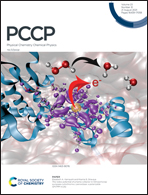Optimization of the photo-orientation rate of an azobenzene-containing polymer based on a kinetic model of photoinduced ordering†
Abstract
The explicit dependence of the rate of photoinduced ordering (photo-orientation) of an azobenzene-containing liquid-crystalline polymer on the photostationary concentration of cis-azobenzene has been predicted theoretically and found experimentally. The employed kinetic model based on the photoinduced rearrangement of the domain structure of a liquid-crystalline material predicts the maximum rate of photo-orientation at ca. 50% content of the cis-isomer in the photostationary state of irradiation. For experimental fine tuning of the photostationary trans–cis ratio, the simultaneous irradiation of material with two beams of light with different wavelengths was employed. The excellent agreement of theory and experiment indicates that the difference of photostationary fractions of cis-azobenzene fragments in adjacent domains of different orientations is the driving force of photoinduced ordering.

- This article is part of the themed collection: 2021 PCCP HOT Articles


 Please wait while we load your content...
Please wait while we load your content...